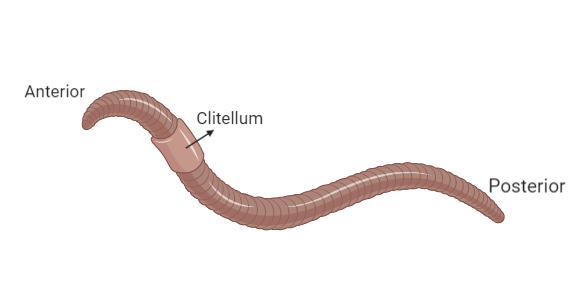
Animals of which phylum exhibit tube within tube structure?
A. Coelenterata
B. Platyhelminthes
C. Cestoda
D. Annelida
Answer
549k+ views
Hint:Most of the animals have a tube inside a tube body plan. In this scheme two openings are required: one to feed in the body (mouth), one to leave the body with waste (anus). The tube-in-one tube plan enables portions of the tube to be specialized, such as the liver, intestine, etc.
Complete answer:
The Phylum Annelida belongs to the kingdom of Animalia and is a very large phylum. The Annelids are present in habitats that are both marine and terrestrial. There are invertebrate species that are bilaterally symmetrical. They breathe through their body surface. Their segmented body separates them from any other creature. Their body contains hemoglobin, which gives them a red color. Most of the Annelids are hermaphrodite, i.e., there are male and female organs in the same body. They both sexually and asexually reproduce. The others sexually reproduce. The members of class Annelida are earthworms, ragworms, and leeches.

Coelenterata has only opening acts both as the mouth (food intake) and anus (digested waste passed out for the digestion of this kind of digestive tract are called incomplete animals with blind-sack species.
The bilateral corporeal plan of the Platyhelminthes has a head with a brain and a stereo eye that actively hunts it. Her mouth and pharynx are in the middle of her bottom and thus incomplete. The gut does not disperse food to other areas of the body without a circulatory system.
Cestoda has no digestive system, so they must eat food that another animal already digests. For this reason, they reside in our intestines as a parasite. They remain bound to the intestines of the host.
The tube within a tube is the annelid body plan. This means that in the coelomic cavity there is a superficial blanket of muscle, epidermis, and cuticle and an internal blanket of the digestive system.
Hence, the correct answer is option D- Annelida.
Note:
The tube in a tube expression is a simple way to think of the structure of the nematode body and is often used to refer to a significant pattern in triploblastic metazoan evolution (Brusca and Brusca, 1990 Invertebrates). The creation of a fluid-filled cavity from the outer wall of the body to the digestive tract. The existence of this cavity resulted in three grades of metazoan, acoelomate, pseudocoelomate, and eucoelomates (Brusca and Brusca, 1990 figures) being grouped together.
Complete answer:
The Phylum Annelida belongs to the kingdom of Animalia and is a very large phylum. The Annelids are present in habitats that are both marine and terrestrial. There are invertebrate species that are bilaterally symmetrical. They breathe through their body surface. Their segmented body separates them from any other creature. Their body contains hemoglobin, which gives them a red color. Most of the Annelids are hermaphrodite, i.e., there are male and female organs in the same body. They both sexually and asexually reproduce. The others sexually reproduce. The members of class Annelida are earthworms, ragworms, and leeches.

Coelenterata has only opening acts both as the mouth (food intake) and anus (digested waste passed out for the digestion of this kind of digestive tract are called incomplete animals with blind-sack species.
The bilateral corporeal plan of the Platyhelminthes has a head with a brain and a stereo eye that actively hunts it. Her mouth and pharynx are in the middle of her bottom and thus incomplete. The gut does not disperse food to other areas of the body without a circulatory system.
Cestoda has no digestive system, so they must eat food that another animal already digests. For this reason, they reside in our intestines as a parasite. They remain bound to the intestines of the host.
The tube within a tube is the annelid body plan. This means that in the coelomic cavity there is a superficial blanket of muscle, epidermis, and cuticle and an internal blanket of the digestive system.
Hence, the correct answer is option D- Annelida.
Note:
The tube in a tube expression is a simple way to think of the structure of the nematode body and is often used to refer to a significant pattern in triploblastic metazoan evolution (Brusca and Brusca, 1990 Invertebrates). The creation of a fluid-filled cavity from the outer wall of the body to the digestive tract. The existence of this cavity resulted in three grades of metazoan, acoelomate, pseudocoelomate, and eucoelomates (Brusca and Brusca, 1990 figures) being grouped together.
Recently Updated Pages
The number of solutions in x in 02pi for which sqrt class 12 maths CBSE

Write any two methods of preparation of phenol Give class 12 chemistry CBSE

Differentiate between action potential and resting class 12 biology CBSE

Two plane mirrors arranged at right angles to each class 12 physics CBSE

Which of the following molecules is are chiral A I class 12 chemistry CBSE

Name different types of neurons and give one function class 12 biology CBSE

Trending doubts
One Metric ton is equal to kg A 10000 B 1000 C 100 class 11 physics CBSE

Explain zero factorial class 11 maths CBSE

What is 1s 2s 2p 3s 3p class 11 chemistry CBSE

Discuss the various forms of bacteria class 11 biology CBSE

State the laws of reflection of light

An example of chemosynthetic bacteria is A E coli B class 11 biology CBSE




